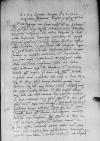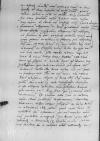Habuimus ⌊⌋
S(trenuita)tis or S(incerita)tis⌈S(trenuita)tisS(trenuita)tis or S(incerita)tis⌉
Tuae superinscribed⌈TuaeTuae superinscribed⌉ hoc mense Augusti sub data ⌊Toleti⌋, 1525-06-01⌊prima Iunii1525-06-01⌋, ex quibus intelleximus suam utilem diligentiam in conficienda confirmatione capitulorum matrimonii nostri impensam. Cuius quidem expeditionis et litterarum desuper fiendarum misit nobis exemplar, in quo placet illa clausula, videlicet quod perinde valeant ac si tunc confirmata fuissent tempore contracti et consummati matrimonii nostri. Verum tamen hoc, quod magis necessitabamur et propter quid nos illam confirmationem exigebamus, illud non datur, videlicet declaratio super illa clausu written over a⌈auu written over a⌉la in V-to matrimonii articulo, qui written over uod⌈uoduiui written over uod⌉ incipit: „Item dicit eadem illustrissima ⌊Isabella⌋ se habere, tenere et possidere iusto titulo et bona fide etc. usque ibi ita, quod ipsorum bonorum stabilium quocumque nomine appellatorum neque totum, neque partem aliquam, cuiuscumque modi sit, possit vendere, donare, ad pias causas relinquere, neque ullo alio modo alienare sine expresso consensu et bona voluntate tam ipsius illustrissimae dominae ⌊Bonae⌋, quam ipsius serenissimi ⌊regis⌋, eius coniugis, sed tantum de annuis praedictorum bonorum redditibus liceat ipsi illustrissimae dominae Isabellae facere, quod libuerit,[1] sed integram omnium stabilium rerum successionem ipsi illustrissimae dominae Bonae et eius ut supra successoribus servare teneatur etc.”.
Super hac igitur particula ultima dubium oritur. Nam ⌊mater nostra⌋, existens iam usufructuaria dumtaxat, quando requirebat a nobis consensum ad obligandum  BCz, 1601, p. 572 seu testandum nonnullis certas pecuniarum summas in bonis huiusdem et illum consensum ad tantas summas, quales voluit, habere a nobis non potuit, nam exhaurirent fere totam hereditatem nostram. Extunc ⌊mater nostra⌋, dum vixit, non obtento nostro consensu tales, quales adversarii nostri voluerunt, fecit testamentaliter on the margin⌈adversarii nostri voluerunt, fecit testamentaliteradversarii nostri voluerunt, fecit testamentaliter on the margin⌉ pecuniarias obligationes in bonis hereditatis nostrae et ita potuisse, quas quidem obligationes isti adversarii nostri fundant in hac praeinserta particula matrimonii, quam petunt et volunt in favorem suum interpretari.
BCz, 1601, p. 572 seu testandum nonnullis certas pecuniarum summas in bonis huiusdem et illum consensum ad tantas summas, quales voluit, habere a nobis non potuit, nam exhaurirent fere totam hereditatem nostram. Extunc ⌊mater nostra⌋, dum vixit, non obtento nostro consensu tales, quales adversarii nostri voluerunt, fecit testamentaliter on the margin⌈adversarii nostri voluerunt, fecit testamentaliteradversarii nostri voluerunt, fecit testamentaliter on the margin⌉ pecuniarias obligationes in bonis hereditatis nostrae et ita potuisse, quas quidem obligationes isti adversarii nostri fundant in hac praeinserta particula matrimonii, quam petunt et volunt in favorem suum interpretari.
Nos autem pro certo scimus et sunt adhuc boni testes intentionis et propositi ⌊matris nostrae⌋, quod ipsa mater nostra, dum vixit, illa verba ultima videlicet: „Sed tantum de annuis dictorum bonorum fructibus reditibus liceat ipsi illustrissimae dominae Isabellae facere quod libuerit etc.” intelligebat hoc vita sua durandum, sed afficere non d{u}ebuerunt verba illa bona nostra nec nos hered(es) et successor(es) eorum. Alias ita nos ⌊mater nostra⌋ exhereditare potuisset obligata in bonis illis aliqua magna summa nec a nobis in vita requisivisset consensum, si ista obligatio debuisset aut potuisset durare post mortem eius, nam foret hoc contrarium capitulis matrimonii nostri superinscribed⌈nostrinostri superinscribed⌉.
Et propterea
S(trenui)tas or S(inceri)tas⌈S(trenui)tasS(trenui)tas or S(inceri)tas⌉ Tua, si nondum misit illud privilegium confirmationis capitulorum matrimonii, instet adhuc diligenter, quod talis declaratio et interpretatio ibidem addatur, quali opus foret ad excludendum istos testamentarios, qui nos impedire volunt suis fraudibus et ingeniis, cum decreto caesareo taliter iudicando et decernendo per concilium et alios sublata eis facultate ... illegible⌈...... illegible⌉ et potestate aliter iudicandi et  BCz, 1601, p. 573 interpretandi, quam ⌊caesar⌋ interpretaverit.
BCz, 1601, p. 573 interpretandi, quam ⌊caesar⌋ interpretaverit.
Si vero illud privilegium confirmationis iam misit, extunc faciat omnem diligentiam, quam poterit, maiorem, ut ad partem hanc habeat declarationem et interpretationem sufficientem quo ad hoc, quod illae obligationes sint nullius roboris et momenti et quod non afficiebant bona et personam nostram, quia intelligi debent vita ⌊matris nostrae⌋ durante et non post[2] mortem superinscribed⌈mortemmortem superinscribed⌉. Alioquin praeiudicarent capitulis matrimonii et circumvenirent nos, ac excluderent ab hereditate nostra hoc pacto, quo adversarii nostri illa interpretari volunt. Et cuius est condere, illius et interpretari.
Si ergo ⌊caesarea maiestas⌋ confirmavit, interpretetur et decernat exnunc prout extunc etc. Et tunc si impediemur non obstan(te) primo privilegio
confirmatio(n)e
utemur tunc ista declaratione ad partem. Alioquin appellabimus ad caesarem. on the margin⌈Et tunc si impediemur non obstan(te) primo privilegio
confirmatio(n)e or confirmatio(nis)⌈confirmatio(n)econfirmatio(n)e or confirmatio(nis)⌉
utemur tunc ista declaratione ad partem. Alioquin appellabimus ad caesarem.Et tunc si impediemur non obstan(te) primo privilegio
confirmatio(n)e
utemur tunc ista declaratione ad partem. Alioquin appellabimus ad caesarem. on the margin⌉ Quod quidem interpretationis privilegium si et postquam obtinuerit
S(trenui)tas or S(inceri)tas⌈S(trenui)tasS(trenui)tas or S(inceri)tas⌉ Tua, illud nobis transmittat per primum occurrentem et tunc cogitabimus revocare et honestare
S(trenuita)tem or S(incerita)tem⌈S(trenuita)temS(trenuita)tem or S(incerita)tem⌉ Tuam.
Si vero istam interpretationem non habebit, illuc durabit, donec nos experiemur iure cum istis legatariis adversariis nostris et si concilium collaterale, quod in hac causa suspectum habemus, vellet interpretari ista verba in capitulo matrimonii contenta in favorem adversariorum et in praeiudicium nostrum, quod nobis molestum foret. Extunc mox appellabimus ad ⌊caesaream maiestatem⌋ ii et ibi
S(trenuita)tas or S(incerita)tas⌈S(trenuita)tasS(trenuita)tas or S(incerita)tas⌉ Tua prosequetur et terminabit hanc causam nostram, nam agitur super summa quinquaginta millium et ultra.
Nec deerit expensa
S(trenui)tati or S(inceri)tati⌈S(trenui)tatiS(trenui)tati or S(inceri)tati⌉
Tuae. Iam enim a quattuor mensibus scripsimus magnifico ⌊Ludovico⌋, ut Tuae S(trenui)tati or S(inceri)tati⌈S(trenui)tatiS(trenui)tati or S(inceri)tati⌉ provideat singulis mensibus de octoginta ducatis  BCz, 1601, p. 574 et committeret ibi uni mercatori, quem S(trenui)tati or S(inceri)tati⌈S(trenui)tatiS(trenui)tati or S(inceri)tati⌉ Tuae iamdudum describere debuit, a quo huiusmodi pecuniae repetendae forent, et iam omnino credimus, quod
S(trenui)tas or S(inceri)tas⌈S(trenui)tasS(trenui)tas or S(inceri)tas⌉ Tua tales litteras a Ludovico habuit. Nam ille ⌊Ludovicus⌋ iam hoc fecit, sed nos miramur, quod adhuc nobis S(trenui)tas or S(inceri)tas⌈S(trenui)tasS(trenui)tas or S(inceri)tas⌉ Tua desuper nil {nobis} respondit. Nolumus autem autem, quod deinceps aliquid a ⌊Focaris⌋ capiat, quibus ⌊hic⌋ iam satisfecimus de illis CCC-tis ducatis ultimo receptis et cedulam repetimus.
BCz, 1601, p. 574 et committeret ibi uni mercatori, quem S(trenui)tati or S(inceri)tati⌈S(trenui)tatiS(trenui)tati or S(inceri)tati⌉ Tuae iamdudum describere debuit, a quo huiusmodi pecuniae repetendae forent, et iam omnino credimus, quod
S(trenui)tas or S(inceri)tas⌈S(trenui)tasS(trenui)tas or S(inceri)tas⌉ Tua tales litteras a Ludovico habuit. Nam ille ⌊Ludovicus⌋ iam hoc fecit, sed nos miramur, quod adhuc nobis S(trenui)tas or S(inceri)tas⌈S(trenui)tasS(trenui)tas or S(inceri)tas⌉ Tua desuper nil {nobis} respondit. Nolumus autem autem, quod deinceps aliquid a ⌊Focaris⌋ capiat, quibus ⌊hic⌋ iam satisfecimus de illis CCC-tis ducatis ultimo receptis et cedulam repetimus.
De domino ⌊Sigismundo Gofredo⌋ bene fecit S(trenui)tas or S(inceri)tas⌈S(trenui)tasS(trenui)tas or S(inceri)tas⌉ Tua, quod ei gratiam nostram promisit. Experietur eam facto uberiorem pro se et suis omnibus, quando se ita fide et integerrime accomodaverit negotiis nostris superinscribed⌈nostrisnostris superinscribed⌉. Et propter suam virtutem acceptavimus suum consanguineum in officialem nostrum. Et uterque illorum habebit nos semper pro voto omni voto suo honesto, quando ipsi ita se accomodabunt negotiis nostris, prout nobis placuerit et utile fuerit, et illis decuerit. Et nullam sua consanguinea sua a nobis patietur iniuriam nec aliquod impedimentum.
Bene valeat
S(trenui)tas or S(inceri)tas⌈S(trenui)tasS(trenui)tas or S(inceri)tas⌉ Tua et nobis frequentius scribat.
 BCz, 1601, p. 572 seu testandum nonnullis certas pecuniarum summas in bonis huiusdem et illum consensum ad tantas summas, quales voluit, habere a nobis non potuit, nam exhaurirent fere totam hereditatem nostram. Extunc
BCz, 1601, p. 572 seu testandum nonnullis certas pecuniarum summas in bonis huiusdem et illum consensum ad tantas summas, quales voluit, habere a nobis non potuit, nam exhaurirent fere totam hereditatem nostram. Extunc  BCz, 1601, p. 573 interpretandi, quam
BCz, 1601, p. 573 interpretandi, quam  BCz, 1601, p. 574 et committeret ibi uni mercatori, quem S(trenui)tati or S(inceri)tati⌈S(trenui)tatiS(trenui)tati or S(inceri)tati⌉ Tuae iamdudum describere debuit, a quo huiusmodi pecuniae repetendae forent, et iam omnino credimus, quod
S(trenui)tas or S(inceri)tas⌈S(trenui)tasS(trenui)tas or S(inceri)tas⌉ Tua tales litteras a Ludovico habuit. Nam ille
BCz, 1601, p. 574 et committeret ibi uni mercatori, quem S(trenui)tati or S(inceri)tati⌈S(trenui)tatiS(trenui)tati or S(inceri)tati⌉ Tuae iamdudum describere debuit, a quo huiusmodi pecuniae repetendae forent, et iam omnino credimus, quod
S(trenui)tas or S(inceri)tas⌈S(trenui)tasS(trenui)tas or S(inceri)tas⌉ Tua tales litteras a Ludovico habuit. Nam ille 



